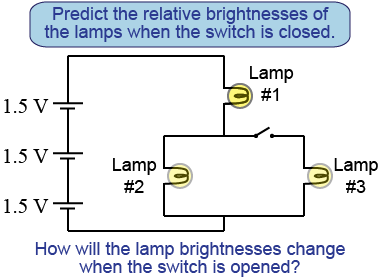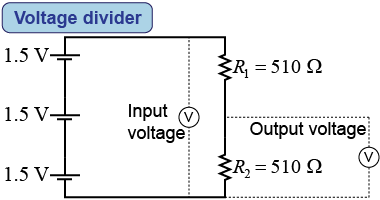| | Essential questions | | How and voltage, current, and power be used to predict the behavior of electric circuits? | |
|
When designing circuits, it is important to know which elements dissipate the most power to prevent the circuit from overheating and causing a fire. As the number of resistive elements increases, however, it can take some thought and calculation to determine how much power is dissipated from each resistor or lamp. In the first part of this investigation, you will predict brightnesses of lamps—the dissipated power—in a circuit. In the second part, you will explore the properties of a commonly-used type of circuit called a voltage divider.

|
Part 1: Power dissipated by elements in a compound circuit

- For the circuit at right, predict the relative brightnesses of the lamps when the switch is closed and when it is open.
- Construct the circuit.
- Note the brightnesses of the lamps when the switch is closed.
- Open the switch and note how the brightnesses have changed.
- Using Kirchhoff’s laws and/or an equation for power, justify your prediction for the relative brightnesses of the lamps when the switch is closed.
- Did the brightness of lamp #1 change when the switch was opened? Provide an explanation.
- Did the brightness of lamp #2 change when the switch was opened? Provide an explanation.

|
Part 2: Voltage divider

- Construct the circuit at right.
- Measure the input voltage and the output voltage.
- Replace resistor #1 with two different resistors and measure the output voltage in each case.
- Replace resistor #2 with two different resistors and measure the output voltage in each case.
- How does the output voltage vary with R1?
- How does it vary with R2?
- Create a mathematical model to predict the output voltage using the values of the input voltage and the two resistances.
- Why is this circuit called a voltage divider?

|
| |
|

